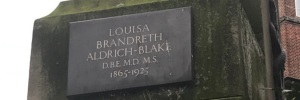Recently, I had the pleasure of visiting the captivating “The Rossettis” exhibition at Tate Britain, which reminded me of the influential presence of Christina Rosetti in my childhood through her enchanting children’s poems. However, it wasn’t until then that I discovered another aspect of Rosetti’s life—one that connected her to the St Mary Magdalene House of charity in Highgate, a refuge for ex-prostitutes, where she devoted 11 years of her life from 1859 to 1870. This revelation led me to delve deeper into the intriguing history of the Soho Bazaar and its intent to aid those in need, a subject that seemed to resonate with Rosetti’s works.

The Soho Bazaar: A Haven of Craft and Charity
Located at 4-5-6 Soho Square (now 4-6 Soho Square), the Soho Bazaar emerged under the guidance of John Trotter—a prominent figure in the army contracting business during the Napoleonic Wars. Initially established as a warehouse to support his business operations, the bazaar later transformed into a vast indoor market to provide a platform for the sale of crafts created by widows and daughters of army officers and other individuals in need.
The market offered an array of goods, including jewellery, millinery, baskets, gloves, lace, potted plants, and books, all available for rent at reasonable rates to stallholders. A visit to Dean Street today allows a glimpse through the iron gates into the original warehouse, allowing visitors to envision the bustling activity that once filled its halls.
Inspiration and Themes in Rosetti’s Poetry
Christina Rosetti’s celebrated poem, “Goblin Market,” is believed to have drawn inspiration from the plight of fallen women. This theme resonated not only with Rosetti but also with her brother, the renowned painter Dante Gabriel Rossetti. One of Dante Gabriel Rossetti’s notable works, “Found” (1851), depicts a poignant story according to Dante’s niece Helen Rosetti. It tells the tale of a young drover encountering his former sweetheart, who had become a fallen woman, as he drove a calf to market.
The concept of the fallen woman, someone who had lost her innocence and fallen from the grace of God, permeated Victorian literature and art. This theme captivated readers and art critics alike due to its topicality, as many Victorian women faced the real risk and prospect of societal condemnation and exclusion.
Soho Bazaar: A Beacon of Support and Social Change
The success of the Soho Bazaar can be attributed to its ability to rally support from both the high-born and wealthy shoppers who frequented the market and the stallholders themselves. Stallholders were required to dress modestly, and the presence of a matron and private constables ensured order and propriety. The bazaar not only aimed to assist respectable war widows but also sought to combat the alarming influx of young and innocent women into the perils of London’s underbelly, which included rampant prostitution in the heart of Soho.
Despite society’s tendency to turn a blind eye to the plight of fallen women, the Soho Bazaar emerged as a beacon of hope and support. By addressing the needs of the marginalized and offering them an opportunity to earn a living, the bazaar played a significant role in empowering women and mitigating the potentially disastrous consequences they faced.
Soho Bazaar’s Influence and Legacy
The Soho Bazaar proved to be a pivotal hub for both commerce and social change. Notably, it attracted a diverse range of individuals, including the esteemed artist J.M.W. Turner, who attended the Soho Academy located in the square. Turner himself was known to have sold his early paintings at the bazaar and procured his drawing materials from there—an intriguing connection between the renowned artist and this bustling marketplace.
Over time, the Soho Bazaar’s popularity grew, leading to its eventual relocation to 77 Oxford Street, where it continued to thrive. Its enduring success stands as a testament to the community’s desire to support charitable initiatives and provide opportunities for those in need.
Today, while the original Soho Bazaar no longer exists, echoes of its legacy can still be found in the stories and remnants that remain. Soho Square, with its rich history and vibrant atmosphere, serves as a reminder of the bustling marketplace that once stood at its heart. The iron gates and glimpses into the past through Dean Street offer a glimpse into the bustling energy that once permeated the Soho Bazaar.

Reflecting on the Influence of Christina Rosetti and the Soho Bazaar
As I left the Rossettis exhibition at Tate Britain, my mind was filled with a newfound appreciation for Christina Rosetti’s connection to the St Mary Magdalene House of Charity and her exploration of themes related to fallen women. The profound impact of the Soho Bazaar, both in supporting marginalized women and fostering social change, became even more apparent.
The intersection of art, literature, and philanthropy is a testament to the power of creativity and compassion. It is through the works of artists and the initiatives of individuals like John Trotter that societal attitudes can be challenged, and support can be extended to those in need.
In conclusion, the exploration of Christina Rosetti’s life and the Soho Bazaar provides a unique window into a remarkable period in history. The interconnectedness of art, literature, and charitable endeavours reminds us of the lasting impact that creative expression and social consciousness can have on society. The Soho Bazaar stands as a symbol of hope, empowerment, and compassion—a beacon of support that continues to inspire us to this day.
Discover More at Tate Britain’s “The Rossettis” Exhibition
For those interested in delving deeper into the lives and works of Christina Rosetti and Dante Gabriel Rossetti, I highly recommend visiting the “The Rossettis” exhibition at Tate Britain. This immersive experience offers a captivating journey into the world of these influential artists, shedding light on their artistic processes, inspirations, and profound impact on the art world.
Visit the Tate Britain website to explore exhibition details, opening hours, and ticket information. Don’t miss this extraordinary opportunity to delve into the lives and artistry of the Rossettis and discover the captivating stories that lie within their masterpieces.
Soho Square is one of the stops on my Settling in Soho Walk – come see where the Bazaar was for yourself and all the Square and Soho’s glorious colourful history!




